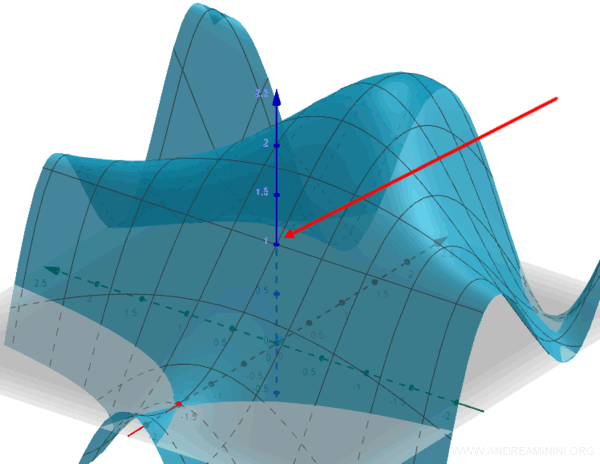Continuity in Functions of Two Variables f(x,y)
A function of two or more variables \(f: \mathbb{R}^n \to \mathbb{R}\) is said to be continuous at a point \(\vec{x}_0 \in \mathbb{R}^n\) if the limit of the function at \(\vec{x}_0\) coincides with the value of the function at that point: \[ \lim_{ \vec{x} \rightarrow \vec{x}_0 } f( \vec{x} ) = f( \vec{x}_0 ) \] where \(\vec{x}_0\) is a vector consisting of \(n\) real components.
For example, a function of two variables f(x, y) is continuous at (x0, y0) if the limit as (x, y) approaches (x0, y0) equals f(x0, y0).
$$ \lim_{(x,y) \rightarrow (x_0,y_0)} f(x,y) = f(x_0,y_0) $$
In this case, \((x_0, y_0)\) is simply an ordered pair of real numbers, rather than a vector in the formal sense.
However, we can treat the pair (x0, y0) as a two-dimensional vector:
$$ \vec{x}_0 = \begin{pmatrix} x_0 \\ y_0 \end{pmatrix} $$
Likewise, any generic pair (x, y) can be represented as a two-component vector:
$$ \vec{x} = \begin{pmatrix} x \\ y \end{pmatrix} $$
By expressing the limit in terms of vectors, we obtain what’s known as the vector form of the limit:
$$ \lim_{\vec{x} \rightarrow \vec{x}_0} f( \vec{x} ) = f( \vec{x}_0) $$
This definition is entirely equivalent to the previous one expressed in terms of scalar pairs.
Note. The vector-based definition of a limit closely mirrors the standard limit definition for a single-variable function f(x). The key difference is that here, the input \( \vec{x} \) is a vector with two components.
Why prefer the vector definition?
The vector notation generalizes naturally to functions of three variables, such as f(x, y, z), and more generally to functions of n variables, like f(x1, x2, ..., xn). This makes the notation both more concise and more powerful in higher dimensions.
A Practical Example
Consider the limit of the function f: ℝ2 → ℝ given by
$$ \lim_{(x,y) \rightarrow (0,0) } \sin y + \cos xy $$
We can evaluate this by separating the limit into two parts:
$$ \lim_{(x,y) \rightarrow (0,0) } \sin y + \lim_{(x,y) \rightarrow (0,0) } \cos xy $$
As (x, y) approaches (0, 0), we observe that sin y tends to 0, while cos(xy) approaches 1.
$$ \lim_{(x,y) \rightarrow (0,0) } \sin y + \lim_{(x,y) \rightarrow (0,0) } \cos xy = 0 + 1 = 1 $$
Therefore, the limit of the function f(x, y) exists and is equal to 1:
$$ \lim_{(x,y) \rightarrow (0,0) } \sin y + \cos xy = 1 $$
Substituting x = 0 and y = 0 directly into the function yields the same result:
$$ f(0,0) = \sin y + \cos xy = \sin 0 + \cos 0 = 0 + 1 = 1 $$
Since the limit and the function value agree, we conclude that the function is continuous at the point (0,0).
$$ \lim_{(x,y) \rightarrow (0,0) } \sin y + \cos xy = f(0,0) = 1 $$
From a geometric perspective, \(f(x, y)\) defines a surface in three-dimensional space \((x, y, z)\), where \(z = f(x, y)\).

Continuity at the point \((x_0, y_0)\) is reflected in the fact that the surface is smooth at the corresponding point \((x_0, y_0, f(x_0, y_0))\), with no gaps, jumps, or sharp corners.
And so on.
